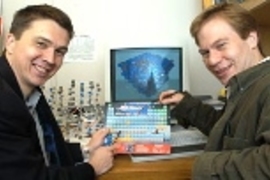A computational technique used to predict everything from books that a given customer might like to the function of an unknown protein is now being applied by MIT engineers and colleagues to the search for new materials.
The team's ultimate goal: a public online database that could aid the design of materials for almost any application, from nanostructure computer components to ultralight, high-strength alloys for airplanes.
The technique, known as data mining, uses statistics and correlations to search for patterns within a large data set. Those patterns can then be used to predict an unknown. "Amazon.com, for example, tracks a customer's past purchases, then uses data mining to suggest, based on those purchases, additional books the customer might like," said Dane Morgan, a research associate in the Department of Materials Science and Engineering (DMSE).
The technique also has applications in science. Applied to a protein database containing "essentially all the known data on protein structure," Morgan said, data mining "assists researchers in exploring the structure, properties and functions of other proteins."
Now Morgan and colleagues have shown that data mining can also make the search for new materials easier. They describe their work in a recent paper in Physical Review Letters.
Authors are Stefano Curtarolo (Ph.D. 2003); Morgan; Gerbrand Ceder, the R.P. Simmons Professor of Computational Materials Science; Kristin Persson, an MIT postdoctoral associate when the work was conducted; and John Rodgers of Toth Information Systems in Canada. Curtarolo, now an assistant professor at Duke University, wrote his thesis on the work and is continuing to develop it in collaboration with his MIT colleagues.
Throughout history, scientists have created new materials with novel characteristics by experimentation, essentially melting together existing materials, then painstakingly characterizing the structure of the resulting product. "The behavior of any material flows from its structure," Morgan noted.
With state-of-the-art computational techniques, or ab initio methods, engineers can now do virtual screenings of potential materials. A computer predicts what structure and properties a given mixture might have, based on fundamental equations of quantum mechanics. Ceder's Lab for Computational Materials Science specializes in ab initio calculations (see story at left).
Even these virtual screenings, however, can be time-consuming and costly because "there are still so many possible structures for any given material that it's impractical for the computer to explore them all," Morgan said.
The new MIT technique "establishes patterns among the many thousands of different possible structures" for a given mixture of materials, he said. "These patterns can then be used to greatly reduce the number of structures the computer has to explore."
To date, the MIT team has tested the technique on a relatively small homegrown database. Recently, however, they received funding from the National Science Foundation to produce a public online database "that will allow the whole computational materials community to contribute calculated data," Morgan said.
The team is excited that the materials database will allow the "recycling" of data from past ab initio computer calculations and laboratory experiments. "Until now, researchers have made no formal use of their older calculations, simply starting again with each new material, thereby throwing away a huge amount of information," Curtarolo said.
"Just as recycling old cans allows one to avoid waste, the ability to recycle old calculated data will avoid wasted and useless calculations in the future. In addition, old calculations for already investigated systems might be used to predict properties of new systems.
"We believe this database and associated data-mining tools will become a standard tool for scientists studying new materials systems," Curtarolo concluded.
The Lab for Computational Materials Science is funded by the Department of Energy and the MIT Center for Materials Science and Engineering through the MRSEC program of the National Science Foundation. In addition, Hewlett-Packard recently donated a million-dollar supercomputer to the lab.







